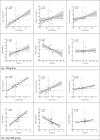Morphologies and composition changes in nonculprit subclinical atherosclerosis in diabetic versus nondiabetic patients with acute coronary syndrome who underwent long-term statin therapy
- PMID: 37005448
- PMCID: PMC10067820
- DOI: 10.1038/s41598-023-32638-w
Morphologies and composition changes in nonculprit subclinical atherosclerosis in diabetic versus nondiabetic patients with acute coronary syndrome who underwent long-term statin therapy
Abstract
Although patients are undergoing similar lipid-lowering therapy (LLT) with statins, the outcomes of coronary plaque in diabetic mellitus (DM) and non-DM patients are different. Clinical data of 239 patients in this observational study with acute coronary syndrome was from our previous randomized trial were analyzed at 3 years, and 114 of them underwent OCT detection at baseline and the 1-year follow-up were re-anlayzed by a novel artificial intelligence imaging software for nonculprit subclinical atherosclerosis (nCSA). Normalized total atheroma volume changes (ΔTAVn) of nCSA were the primary endpoint. Plaque progression (PP) was defined as any increase in ΔTAVn. DM patients showed more PP in nCSA (ΔTAVn; 7.41 (- 2.82, 11.85) mm3 vs. - 1.12 (- 10.67, 9.15) mm3, p = 0.009) with similar reduction of low-density lipoprotein cholesterol (LDL-C) from baseline to 1-year. The main reason is that the lipid component in nCSA increases in DM patients and non-significantly decreases in non-DM patients, which leads to a significantly higher lipid TAVn (24.26 (15.05, 40.12) mm3 vs. 16.03 (6.98, 26.54) mm3, p = 0.004) in the DM group than in the non-DM group at the 1-year follow-up. DM was an independent predictor of PP in multivariate logistic regression analysis (OR = 2.731, 95% CI 1.160-6.428, p = 0.021). Major adverse cardiac events (MACEs) related to nCSA at 3 years were higher in the DM group than in the non-DM group (9.5% vs. 1.7%, p = 0.027). Despite a comparable reduction in LDL-C levels after LLT, more PP with an increase in the lipid component of nCSA and a higher incidence of MACEs at the 3-year follow-up was observed in DM patients.Trial registration: ClinicalTrials.gov. identifier: NCT02140801.
© 2023. The Author(s).
Conflict of interest statement
The authors declare no competing interests.
Figures





Similar articles
-
Dynamic natural components and morphological changes in nonculprit subclinical atherosclerosis in patients with acute coronary syndrome and mild chronic kidney disease at the 1-year follow-up and clinical significance at the 5-year follow-up.PLoS One. 2024 May 31;19(5):e0302547. doi: 10.1371/journal.pone.0302547. eCollection 2024. PLoS One. 2024. PMID: 38820294 Free PMC article.
-
Dynamic natural morphologies and component changes in nonculprit subclinical atherosclerosis in patients with acute coronary syndrome at 1-year follow-up and clinical significance at 3-year follow-up.Atherosclerosis. 2022 Sep;356:1-8. doi: 10.1016/j.atherosclerosis.2022.07.013. Epub 2022 Jul 31. Atherosclerosis. 2022. PMID: 35939981
-
Plaque volume and plaque risk profile in diabetic vs. non-diabetic patients undergoing lipid-lowering therapy: a study based on 3D intravascular ultrasound and virtual histology.Cardiovasc Diabetol. 2017 Dec 7;16(1):156. doi: 10.1186/s12933-017-0637-0. Cardiovasc Diabetol. 2017. PMID: 29212544 Free PMC article. Clinical Trial.
-
High-intensity statin therapy and regression of coronary atherosclerosis in patients with diabetes mellitus.J Diabetes Complications. 2015 Jan-Feb;29(1):142-5. doi: 10.1016/j.jdiacomp.2014.10.004. Epub 2014 Oct 13. J Diabetes Complications. 2015. PMID: 25456820 Review.
-
Pitavastatin: novel effects on lipid parameters.Atheroscler Suppl. 2011 Nov;12(3):277-84. doi: 10.1016/S1567-5688(11)70887-X. Atheroscler Suppl. 2011. PMID: 22152282 Review.
Cited by
-
Effect of negative remodeling of the side branch ostium on the efficacy of a two-stent strategy for distal left main bifurcation lesions: an intravascular ultrasound study.J Geriatr Cardiol. 2024 May 28;21(5):506-522. doi: 10.26599/1671-5411.2024.05.003. J Geriatr Cardiol. 2024. PMID: 38948898 Free PMC article.
-
Dynamic natural components and morphological changes in nonculprit subclinical atherosclerosis in patients with acute coronary syndrome and mild chronic kidney disease at the 1-year follow-up and clinical significance at the 5-year follow-up.PLoS One. 2024 May 31;19(5):e0302547. doi: 10.1371/journal.pone.0302547. eCollection 2024. PLoS One. 2024. PMID: 38820294 Free PMC article.
-
Research trends in lipid-lowering therapies for coronary heart disease combined with hyperlipidemia: a bibliometric study and visual analysis.Front Pharmacol. 2024 May 17;15:1393333. doi: 10.3389/fphar.2024.1393333. eCollection 2024. Front Pharmacol. 2024. PMID: 38828451 Free PMC article.
-
Machine Learning Applications in Acute Coronary Syndrome: Diagnosis, Outcomes and Management.Adv Ther. 2025 Feb;42(2):636-665. doi: 10.1007/s12325-024-03060-z. Epub 2024 Dec 6. Adv Ther. 2025. PMID: 39641854 Review.
-
Study on the potential clinical significance of subclinical stent edge effects after drug-eluting stent implantation.Sci Rep. 2025 Mar 10;15(1):8258. doi: 10.1038/s41598-024-81329-7. Sci Rep. 2025. PMID: 40064903 Free PMC article. Clinical Trial.
References
-
- Ference BA, Ginsberg HN, Graham I, et al. Low-density lipoproteins cause atherosclerotic cardiovascular disease. 1. Evidence from genetic, epidemiologic, and clinical studies. A consensus statement from the European atherosclerosis society consensus panel. Eur. Heart J. 2017;38:2459–2472. doi: 10.1093/eurheartj/ehx144. - DOI - PMC - PubMed
Publication types
MeSH terms
Substances
Associated data
LinkOut - more resources
Full Text Sources
Medical
Miscellaneous

